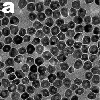
The study, “Nickel Phosphide Nanoparticles with Hollow, Solid, and Amorphous Structures,” provides a step-by-step analysis of how to create solid or hollow nanoparticles that are all made of the same material. “It’s been known that these structures could be made,” says Dr. Joe Tracy, an assistant professor of material science engineering at NC State and co-author of the paper, “but this research provides us with a comprehensive understanding of nanostructural control during nanoparticle formation, showing how to consistently obtain different structures in the lab.” The study also shows how to create solid nanoparticles that are amorphous, meaning they do not have a crystalline structure.
Tracy explains that there is a great deal of interest in the formation of hollow nanoparticles and amorphous nanoparticles. But for many kinds of nanoparticles, there had previously been no clear understanding of how to control the formation of these structures. As a result of the new study, Tracy says, “nanoparticles with desired structures can be made more consistently, making it easier for researchers to determine their electronic, optical and catalytic properties.” For example, amorphous nanoparticles may be of use in future electronic applications or for nanostructure fabrication. Tracy stresses that while the NC State researchers were able to show how to create hollow nanoparticles and amorphous nanoparticles, they were not able to create nanoparticles that were both hollow and amorphous.
The study could also have implications for many additional types of nanoparticles, not just nickel phosphide. Tracy says that the findings “could provide important insights for further studies to control the structures of many other kinds of nanoparticles, with a wide array of potential applications.” These could include metal oxide, sulfide, selenide and phosphide nanoparticles.
Specifically, the researchers found that they could control whether nickel phosphide nanoparticles would be hollow or solid by adjusting the ratio of phosphorus to nickel reactants when they synthesized the nanoparticles. The researchers found that they could create amorphous solid nanoparticles by controlling the temperature.
The study was co-authored by Tracy, NC State post-doctoral researcher Junwei Wang and NC State Ph.D. student Aaron Johnston-Peck. The research was funded by NC State and the National Science Foundation, and was published online in Chemistry of Materials.
Source: North Carolina State University
Image: TEM image of crystalline NiP nanoparticles. Reprinted with permission from Wang J, et al. 2009. Nickel Phosphide Nanoparticles with Hollow, Solid, and Amorphous Structures. Chemistry of Materials 16 September 2009. DOI: 10.1021/cm901073k. Copyright 2009 Amercian Chemical Society.
